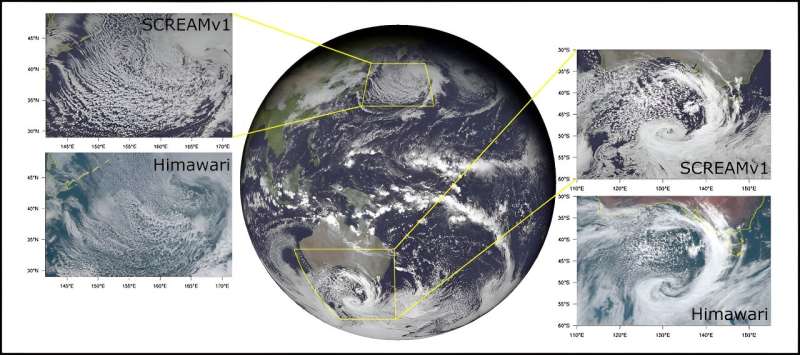This article has been reviewed according to Science X's editorial process and policies. Editors have highlighted the following attributes while ensuring the content's credibility:
fact-checked
trusted source
proofread
Modeling Earth systems at a quintillion calculations per second

Climate models compute vast amounts of information about Earth's climate system—from small water droplets to large-scale weather patterns—to re-create past climate or predict future climate. Accurately re-creating how Earth's energy (measured in watts) is balanced between the atmosphere, land surface, oceans, and sea ice helps scientists understand what factors are causing changes in climate and allows us to better prepare for the future.
To manage the wide range of scales, these computer simulations divide the world into a 3D grid of cells. Modern general circulation models, which simulate the movement of air around the planet, divide the atmosphere into a grid of horizontal squares about 1° across and about 60 vertical levels. Though this resolution is an improvement over earlier versions of these models, it is still low enough to allow for major uncertainty.
Global storm-resolving models (GSRMs) are a newer type of climate model with higher resolution. With grid squares just 5 kilometers across, these types of models can provide more detail and information about severe weather events, such as tropical cyclones. But they still struggle to resolve details of cloud properties (particularly close to Earth's surface) and the vertical movement of atmospheric heat and moisture. Further, their level of detail makes these models both slow and expensive to run on traditional computer hardware.
In a new study published in the Journal of Advances in Modeling Earth Systems, A. S. Donahue and colleagues explored a new GSRM that combines high computational speed with high-resolution modeling: the Simple Cloud-Resolving E3SM Atmosphere Model (SCREAM).
This model is designed to run on exascale computers, which can perform more than 1018 multiplication or addition problems per second—performance that is currently only possible on the two fastest computers in the world. After five years of development, the study's authors ran four 40-day simulations of each season on a 3-kilometer-resolution grid in this new model and compared their results with satellite and ground-based data.
This first iteration of SCREAM re-created the global energy balance to within 1.2 watts per square meter of accuracy, as well as the midlatitude jets and atmospheric rivers responsible for transporting moisture at the poles. SCREAM also captured the diurnal changes (changes over the course of a day) in boundary-level clouds across all four seasons but struggled to capture the midlevel clouds, especially in the tropics. Though still in the developmental stages, SCREAM will provide researchers with a faster way to perform high-resolution climate simulations.
More information: A. S. Donahue et al, To Exascale and Beyond—The Simple Cloud‐Resolving E3SM Atmosphere Model (SCREAM), a Performance Portable Global Atmosphere Model for Cloud‐Resolving Scales, Journal of Advances in Modeling Earth Systems (2024). DOI: 10.1029/2024MS004314
Provided by American Geophysical Union
This story is republished courtesy of Eos, hosted by the American Geophysical Union. Read the original story here.


















